
TABLE GRAPES - ROD AND SPUR PRUNING IN THE TROPICS
SCIENTIFIC NAME: Vitis vinifera
FAMILY: Vitaceae
This article is a follow up to the first one on this subject which was published in the Newsletter No.73, 2/92.
The double pruning method, summer as well as winter pruning, described in that article is quite useless under our conditions. The long spurs of three to four buds as advocated do not set a crop. This is because, under our tropical conditions, the fruitful buds are much further out on the rods than I realized, apparently from about bud six or seven and further out still in some varieties. Thus we live and learn!
So how should we prune table grapes in the Far North? Quite simply by Rod and Spur pruning, which is standard practice when hard pruning wine grapes down south. Thus you only have to prune once, in winter.
ROD AND SPUR PRUNING
Each year in South Australia, grape growers compete in the State Pruning Championships for the best Rod and Spur pruner. Ah, those happy days, judging pruning competitions in the Barossa and Clare Valleys in freezing winter weather, made bearable with an occasional swig of Port to keep the circulation going!!
At winter pruning, 10- to 14-bud rods are wrapped either way along the wires. These rods bear the crop. Two bud spurs are left behind the rods to provide new rods for the following year.
On young vines, when starting them off on a single wire, the rods are cut shorter. As the vine gets older and stronger, more rods can be added and a more substantial trellis erected to accommodate the developing vine.
In a backyard, an overhead pergola is ideal and will make a nice shady bower to sit under on a hot day.
In a commercial planting, a six-wire V trellis, three wires each side, allows easy access for the important work of bunch thinning and trimming on shoots arising from rods wrapped on the two lower wires, the vine's foliage being supported by the top four wires as in Diagram 1.
The V trellis allows good accessibility to the bunches for thinning and trimming operations.
ROD SELECTION
At winter pruning the 010 rods which bore last season's crop are removed and new rods are selected from the back spurs. Thus the vine is left with two to four rods, depending on vigour, wrapped either way along the lower two wires.
From these will arise shoots which will bear the next crop of table grapes as in Diagram 1. Only the best available rods are laid down for fruit bearing. Those with short distances between the nodes (buds) are preferred. When wrapping on the rods, try not to damage the buds. I estimate 10- to 14-bud rods to be about the right length. The end of the rod is cut through the last bud and then, after wrapping, is fastened to the trellis with tie wire or string. The idea of cutting through the end bud is to prevent a shoot growing beyond the tie and to form a knob to prevent the tie wire slipping off.
Always prune to the vigour of the vine. If the vine is strong enough, an extra rod or two can be wrapped on for extra crop, or if the spur has failed to produce a strong enough rod, then a new rod can be taken off the old one as in Diagram 3.
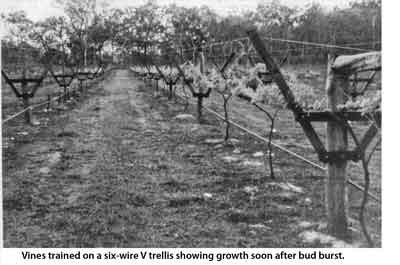 | 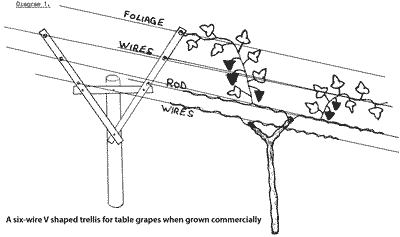 |
SPUR SELECTION
A two-bud spur, or back spur, is left at pruning to provide both a rod (from the top bud) for bearing the following year's crop and another spur (from the lower bud). Why do we call them 'back' spurs? Because they are positioned behind the rods. Why are they positioned behind the rods? Because if they were in front of the rods, the arm of the vine would become excessively elongated at each successive pruning.
At next winter's pruning, the old rods which have borne the crop are cut off. New rods from the back spurs are then wrapped on to replace them as in Diagrams 2 and 3.
As a new rod originates from a back spur, behind the old rod, the arm of that part of the vine is therefore not appreciably increased in length, thus keeping the heart of the vine nice and compact and within the bounds of the trellis.
A spur generally has two buds, that is two clear buds above the base bud. The bottom bud produces the spur for next year and therefore must point in a forward direction along the line of the wire for good shape.
The top bud points in the opposite direction and produces next year's fruiting rod.
At winter pruning, this rod is bent back over the top of the spur and wrapped down on the wire. If it was pointing the other way it would snap off before it could be wrapped on.
Under tropical conditions, spurs, it would seem, do not or very rarely produce fruit.
Sometimes, if a spur fails to produce a good enough rod, a new rod can be taken off the old one. If this is done, be sure to leave a strong back spur so you can get back to it next winter pruning to restore the vine to better shape.
PRUNING FOR SHAPE
Shape is extremely important in Rod and Spur pruning. To maintain good vine shape means good spur selection and not allowing the head of the vine to get too straggly. As a general rule, put in more spurs than rods to ensure you have a good choice of fruit wood (Rods) for next year.
Sometimes it may be necessary to leave only a one-bud spur if the spur is weak, or a three-bud spur in order to have the buds pointing in the right direction.
When pruning, always think ahead to visualize what the vine is going to look like next season.
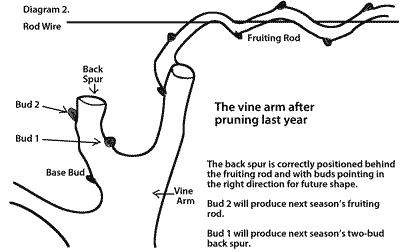 | 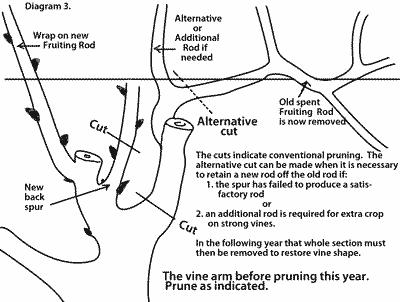 |
THE FLOATING HEAD OR CROTCH
The heads of the vines in the accompanying pictures were all trained for spurs on permanent arms. As our vines in the tropics do not fruit well on spurs, the heads will eventually have to be converted gradually to floating heads or crotches beneath the wires for Rod and Spur pruning.
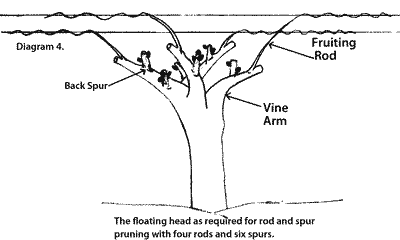
For this style of pruning the head is free-standing and is not attached to the wires as in Diagram 4.
Conversion of these vines to floating heads may take time and is dependant on shoots arising from dormant buds in the older wood.
CONFUSED??
Yes, I know its all very confusing to the beginner. The only way to teach pruning is to demonstrate it on a vine, which I am prepared to do. In the meantime we will get more practical experience with Rod and Spur pruning and how it applies to all the different varieties on trial at present.
DORMEX
The use of the chemical DORMEX on newly-pruned vines is an integral part of growing grapes in the tropics. Without the use of DORMEX you might as well forget about growing grapes in Far North Queensland!
What is DORMEX? The active ingredient is cyanamide. What is it used for? It is used to break bud dormancy. It has been our experience, under our climatic conditions and without using DORMEX, that when bud burst occurs after pruning, only the end buds on the arms or rods of the vine grow.
These shoots are extremely vigorous but the rest of the vine is completely bare of any shoots. Why does this happen? Because of the lack of winter chilling. Our winters are not cold enough. Without winter chilling, bud burst is extremely erratic, the vines produce practically no grapes at all and vine shape is ruined, which makes pruning virtually impossible.
So what are the advantages of using DORMEX?
1. A high percentage of the buds treated burst.
2. Growth is reasonably even along the length of each rod.
3. Bud burst is much earlier than normal, in fact it seems one can prune any time from about April onwards, treat with Dormex and bud burst will occur two to three weeks after application.
4. Some table grape varieties grow vigorously in the tropics. As a high percentage of buds burst after DORMEX treatment and as growth seems fairly even over the vine, the high number of shoots the vine carries tends to even out the vigour. Also the high number of bunches set with Rod pruning has a mollifying effect on vigour.
Under our conditions frost is not a problem, certainly not at trellis height, so there is no fear of frost damage to developing shoots.
Always use a wetting agent with DORMEX. Apply by spraying or painting it on with a brush, taking care to thoroughly soak the buds on the rods and on the spurs around the head of the vine. Follow closely the directions on the tin for mixing and for precautions to take.
TIME OF PRUNING
There are three things which will influence time of pruning:
1. as the rains commence around November, all fruit should be off the vine by that time or the fruit will split.
2. from a commercial point of view, high prices can be obtained for good quality fruit landed on the market in the period August to October.
3. table grape varieties vary in their times of maturing their fruit from time of pruning, from 108 days for early-maturing varieties to 145 days for later-maturing varieties.
So, working back from August, we arrive at the conclusion that if the vines are pruned about the last week in April, the earlier varieties should be ready for picking in August and the later varieties around end of September/beginning of October. Or something like that!
As the threshold temperature for bud growth is probably around 5°C and our winter temperatures are well above that (July mean max. 25.3°C and mean min. 11.2°C), the vines should make satisfactory growth through the winter months.
Whether they will slow up much due to the cooler weather remains to be seen. But by pruning in the end of April, even the later maturing varieties should have been picked by the time the rains commence. Anyway that's the aim of the exercise. Will let you know later if we succeed.
As the vines come into bearing and as time goes on and we gain more practical experience, we should have a better idea of how to manage table grapes in Far North Queensland.
DATE: January 1994
* * * * * * * * * * * * *
